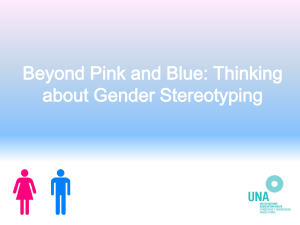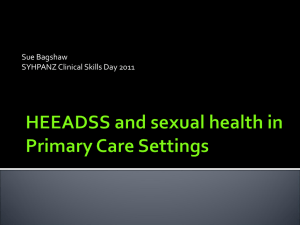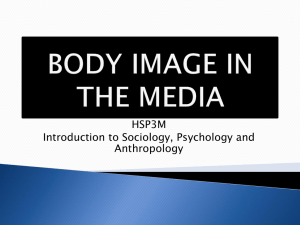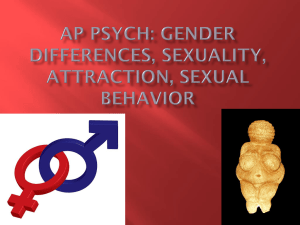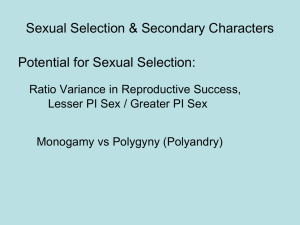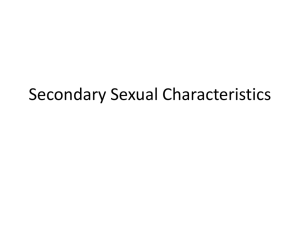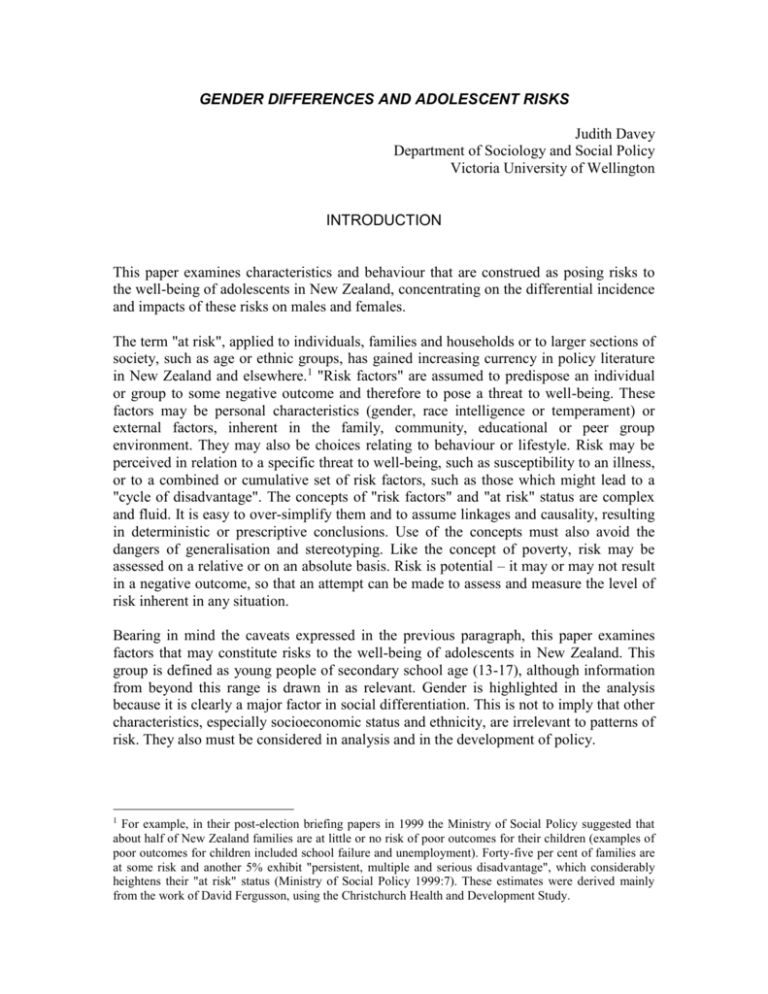
GENDER DIFFERENCES AND ADOLESCENT RISKS
Judith Davey
Department of Sociology and Social Policy
Victoria University of Wellington
INTRODUCTION
This paper examines characteristics and behaviour that are construed as posing risks to
the well-being of adolescents in New Zealand, concentrating on the differential incidence
and impacts of these risks on males and females.
The term "at risk", applied to individuals, families and households or to larger sections of
society, such as age or ethnic groups, has gained increasing currency in policy literature
in New Zealand and elsewhere.1 "Risk factors" are assumed to predispose an individual
or group to some negative outcome and therefore to pose a threat to well-being. These
factors may be personal characteristics (gender, race intelligence or temperament) or
external factors, inherent in the family, community, educational or peer group
environment. They may also be choices relating to behaviour or lifestyle. Risk may be
perceived in relation to a specific threat to well-being, such as susceptibility to an illness,
or to a combined or cumulative set of risk factors, such as those which might lead to a
"cycle of disadvantage". The concepts of "risk factors" and "at risk" status are complex
and fluid. It is easy to over-simplify them and to assume linkages and causality, resulting
in deterministic or prescriptive conclusions. Use of the concepts must also avoid the
dangers of generalisation and stereotyping. Like the concept of poverty, risk may be
assessed on a relative or on an absolute basis. Risk is potential – it may or may not result
in a negative outcome, so that an attempt can be made to assess and measure the level of
risk inherent in any situation.
Bearing in mind the caveats expressed in the previous paragraph, this paper examines
factors that may constitute risks to the well-being of adolescents in New Zealand. This
group is defined as young people of secondary school age (13-17), although information
from beyond this range is drawn in as relevant. Gender is highlighted in the analysis
because it is clearly a major factor in social differentiation. This is not to imply that other
characteristics, especially socioeconomic status and ethnicity, are irrelevant to patterns of
risk. They also must be considered in analysis and in the development of policy.
1
For example, in their post-election briefing papers in 1999 the Ministry of Social Policy suggested that
about half of New Zealand families are at little or no risk of poor outcomes for their children (examples of
poor outcomes for children included school failure and unemployment). Forty-five per cent of families are
at some risk and another 5% exhibit "persistent, multiple and serious disadvantage", which considerably
heightens their "at risk" status (Ministry of Social Policy 1999:7). These estimates were derived mainly
from the work of David Fergusson, using the Christchurch Health and Development Study.
The paper begins by presenting a typology or risk, listing factors commonly assumed to
be associated with negative outcomes. It then reviews recent New Zealand research
findings on a range of risk factors. It does not attempt to assess the proportions of young
people at risk or to measure the degree or intensity of risk.
A TYPOLOGY OF RISK
Risks have been defined as threats to well-being, here considered on an individual basis.
Well-being has many dimensions. It encompasses security: physical, psychological,
social, and economic security. It also includes health in the widest meaning of the term –
mental, physical, social and spiritual health. Many threats to health and security arise
from pathologies within the family, such as violence and abuse of various kinds, and in
society – for example, crime victimisation. Others emanate from lifestyle choices –
smoking, alcohol and drug use, and dangerous behaviour. The high degree of injury and
illness that I related to lifestyle highlights the interactions between health, well-being and
social factors such as living arrangements, work status and income. Well-being is the
result of real-world influences which are complex and interactive.
Table 1 classifies and lists significant threats to the well-being of young people and
indicates whether (according to evidence from recent New Zealand research) males or
females are more likely to be susceptible, or whether the risk affects both groups more or
less equally. The table omits risks that apply only to one sex, such as pregnancy.
Table 1 Adolescent Risks – Gender Differences
Risk Type
Specific Risk
Mental Health and
Behaviour
Behavioural and conduct problems
Truancy
Suspension/expulsion
Mental health problems
Substance dependence
Serious offending/arrest
Delinquency (adolescence limited)
Health
Physical
Sexual
Alcohol misuse
Smoking
Cannabis use
Other drug use
Accidental injury and death
Intentional injury and homicide
Suicide
Suicide attempt
Family violence
Abuse (sexual)
Early sexual experience
Unsafe sexual behaviour
STD
Both
Genders
Mainly
Male
Mainly
Female
X
X
X
X
X
X
X
X
X
X
X
X
X
X
X
X
X
X
X
X
Economic
Financial hardship (family)
Unemployment
Low income
Lack of educational qualifications
X
X
X
X
MENTAL HEALTH AND BEHAVIOUR RISKS
This category ranges from behavioural and conduct problems to serious mental health
disorders, which can be diagnosed clinically. It also includes offending against the law,
from minor delinquency to serious criminal behaviour.
Behaviour and Conduct Problems
Both the Christchurch Health and Development Study (CHDS) and the Dunedin Multidisciplinary Health and Development Study (DMHDS) found that boys were more prone
to behaviour and conduct problems in childhood than girls. The patterns are established
before the age of 10 (Fergusson and Horwood 1995, Fergusson and Horwood 1997,
Feehan et al. 1994). These problems are strongly associated with family disadvantage and
instability and have their sequel in adolescent offending and mental health problems.
Truancy is an indicator of school problems and has been linked to educational failure and
under-achievement. The CHDS showed that 39% of males and 40% of females in the
sample had played truant by the age of 16, so gender differences are not significant
(Fergusson, Lynskey and Horwood 1995:30). Mild and occasional truancy is probably
not pathological, but severe truancy is related to adjustment problems. Suspensions and
expulsions from school are further measures of unacceptable behaviour. On a national
basis the number of suspensions has doubled since 1990, and totalled more than 10,000 in
1998. Over 70% of the latter were of male students. The leading reasons for suspension,
of all students, in 1998 were continual disobedience, physical assaults on other students
and verbal assaults on staff (Ministry of Education data) (no breakdown given by
gender).
Mental Health Problems
Estimates of the incidence of mental ill health among young people vary depending on
how it is defined. McGeorge suggested that 5% of those aged 0-19 have mental health
disorders requiring specialist assessment or treatment (O'Reilly 1996). DMHDS figures
are higher (16% overall at age 13), but all agree that boys significantly outnumber girls in
these statistics (Silva and Stanton 1996:155). There was again an association with family
problems, such as poor maternal mental health and history of parental separation, and
also with poorer language and literacy skills. These problems frequently originate in the
pre- or early school periods, but tend to persist into adolescence.
The Christchurch study showed at age 15 a 26% prevalence of identifiable mental health
disorders (Fergusson, Horwood and Lynskey 1993). In the Dunedin cohort, also at 15, the
rate was 22% (McGee et al. 1990). This grew to 37% by age 18 (Feehan et al. 1994) 2.
Alongside higher male incidence were gender differences in the conditions diagnosed.
Females had higher rates for social phobia and major depression (the most common
categories), but there was a male predominance in alcohol dependence, conduct disorder
and marijuana dependence.
Much mental ill health goes untreated, with serious implications for well-being (see the
later section on suicide). Increased rates of admission to psychiatric hospitals suggest a
higher incidence of serious mental health problems among young adults. The rate of first
admission is high for the 15-19 age group – 22.5 per 1000 for males, and 18.9 per 1000
for females (Ministry of Youth Affairs 1994). The most common reason recorded for
admission at this age is alcohol dependency, heavily weighted to males.
Offending/Delinquency
Adolescents, especially boys, report high levels of minor offending, such as occasional
truancy and experimentation with alcohol, tobacco and cannabis. Much of this could be
considered "normal" adolescent behaviour. Moffit and Harrington (1996) described it as
"Adolescent Limited Delinquency". It accounts for the high proportion of males who
have police contact for minor offences -–25% of New Zealand boys aged 10 in 1967 had
appeared in court before their 25th birthday (Lovell and Norris 1990). Maxwell and
Morris (1993) studied juvenile offenders during the first year of the Children and Young
Persons and their Families Act, 1989. Boys committed most of the more serious offences
and accounted for 83% of those arrested.
Exposure to delinquent peers plus the onset of puberty, about the time of entry to
secondary school, combine as important links to delinquency (Moffit and Harrington
1996:179). Girls may be involved in adolescent-limited delinquency (though not to the
same extent as boys) if they experience early puberty and attend co-educational schools.
Access to delinquent male role models, especially older boys, is a key factor in girls'
delinquency.
Most adolescents lose their motivation for delinquency as adult roles become available
and the consequences of bad behaviour threaten this status. A small proportion, however,
become "Life Course Persistent" offenders and account for a high proportion of criminal
offences. These are predominantly male and have poorer social skills, academic
achievements and mental health than the general group. These characteristics, plus
delinquent behaviour, may lead to outcomes such as drug dependency and imprisonment,
which further trap the group in an antisocial life-path.
The Dunedin study compared the likelihood of delinquency behaviours between males
and females (Moffit and Harrington 1996:184). The male to female ratios were 4.5:1 for
childhood conduct disorder, 7:1 for adult antisocial personality and 2:1 for self-reported
adolescent delinquency. Males committed a higher proportion of the more serious and
2
These studies used the DSM-III-R set of criteria for measuring mental health, but the results may not be
strictly comparable.
violent offences, whereas for youth-oriented crime, such as using drugs, vandalism and
theft, there was a more even incidence between the gender groups.
HEALTH RISKS
Health risks include smoking, cannabis, alcohol and other drug use.
Smoking
A large-scale study of fourth-formers in 1992 found that two-thirds had tried smoking
and 24% were current smokers (more than one cigarette a month) (Ford et al. 1995). Not
only is tobacco use high among children, but it may be increasing. A more recent survey
of 1500 students aged 13-15 found 12% of the boys smoking every day (up from 8% in
1991) and 14% of the girls (up from 11%) (N.Z. Drug Foundation 1997).
As shown in Table 2, by the mid to late teenage years girls are more likely to smoke than
boys, according to DMHDS figures (Silva and Stanton 1996:189). Current smoking was
higher among females than males – 27% and 22% respectively – in the fourth-form study
cited above (Ford et al. 1995). Information from the 1996 Census also shows that more
females are regular smokers (Davey 1998:103). This applies to both dependent and
independent teenagers, although the latter group (living away from home and/or with
their own incomes) have higher smoking rates than the former (who are more likely to be
full-time students), as shown in Table 3.
Table 2 Recent Use (within a month) of Substances by Children under 15
(% of DMHDS sample)
Substance
Tobacco
Age
Males
9
11
13
15
9
11
13
13
15
18
13
15
18
Alcohol
Inhalants
Hard drugs
3
6
11
21
47
43
46
2.5
3.2
2.1
0.3
3.4
8.6
Females
2
7
9
33
45
39
45
1.2
5.8
1.8
0.3
2.6
4.0
Source: Silva and Stanton 1996:192
Table 3 Age Group 15-19, Percentage who are Regular Smokers, by Gender
Male
Dependent
Independent
Total
Source: 1996 Census
11.5
26.2
18.0
Female
13.3
30.5
20.8
Total
12.4
28.3
19.4
The Dunedin study found an association between smoking before age 15 and delinquent
behaviour, for both boys and girls. However, the likelihood of concurrent substance use
was much higher for males, with a strong link between drinking and smoking by age 13,
which did not appear for females (Silva and Stanton 1996:194).
Cannabis
Experimentation with cannabis is very common among teenagers, especially males
(Black and Casswell 1992). As a threat to health it is acknowledged to be less significant
than tobacco and alcohol (Abel and Casswell 1998). However, because it is illegal,
cannabis use has legal consequences. At age 13, 0.8% of males and 1.3% of females in
the DMHDS sample were recent users of cannabis (Silva and Stanton 1996:192). By age
15 at least 10-15% had used it once or more, with no gender differences, but males were
more likely to be users later in adolescence. The early use of cannabis (defined as first
use before the age of 15) has been associated with behavioural problems and poor mental
health, but may be a symptom rather than a cause (Fergusson, Lynskey and Horwood
1993).
Alcohol
A high proportion of New Zealand school children drink alcohol. At ages 9, 11 and 13,
DMHDS figures for alcohol consumption by girls and boys were similar (Table 2). By
age 18, however, alcohol consumption was much higher for males and at this stage girls
reported fewer negative experiences (Silva and Stanton 1996:215-216). A 1997 survey of
14-18 year olds showed that more than half those identified as "heavier" drinkers (defined
as having consumed five or more glasses the last time they drank) were boys, and these
were more likely to be cigarette or cannabis users (ALAC 1997). These studies suggest
that as many as 20% of teenagers are alcohol abusers or alcohol dependent, with evidence
that alcohol leads to problem (and risk-taking) behaviour and violence. Nevertheless
drunkenness is widely condoned throughout New Zealand society, possibly because a
high proportion of adults also consume alcohol.
Papers from the CHDS show links between alcohol misuse and offending at age 14-15,
applying to both males and females (Table 4). Even allowing for common risks, arising
from family background, personal characteristics and peer affiliations, the association
between alcohol misuse and violent offending remains (Fergusson, Lynskey and
Horwood 1996). Being male was also a predictor of self-reported abusive/hazardous
drinking at age 16 (Fergusson, Horwood and Lynskey 1995).
Table 4 Comparison of Rates (per 100) of Violent and Property Offending among Males and
Females who Reported Alcohol Misuse and Remaining Sample Members (age 14-15)
Males
Alcohol misuse
Violent Offences
Property Offences
N
Females
No misuse
32.1
45.3
53
7.6
12.4
42
Source: Fergusson and Lynskey and Horwood 1996.
Other Drug Use
Alcohol misuse
15.4
50.0
126
No misuse
3.1
7.3
453
Adolescents, both males and females, who continue to smoke are also more likely to try
cannabis, inhalants and hard drugs regardless of whether they continue to drink alcohol
(Silva and Stanton 1996:200). Table 2 shows that hard drug use by young teenagers was
very low in the Dunedin study, but had increased by age 18 and was higher for males at
that age (as was the use of inhalants).
PHYSICAL RISKS
Physical risks include accidental and intentional injury and death, suicide, attempted
suicide, sexual risk, abuse and unsafe sexual behaviour.
Accidental and Intentional Injury and Death
Research involving discussion groups of teenagers came to the conclusion that behaviour
which involves taking risks, and therefore encountering potential threats to well-being, is
normal behaviour at this stage of life (Colmar Brunton Research 1993a, 1993b). Younger
teenagers focus on thrill seeking – like riding skateboards and bikes – but by age 16 most
had moved on to experimenting with alcohol and drugs (mainly cannabis). Boys are more
susceptible to thrill seeking, but girls are also at risk. As a result, accidents are the
primary cause of adolescent physical incapacity and death. They account for 46% of
hospital attendance by males aged 15-19, and are the second largest category for females
(after conditions associated with pregnancy) (Davey 1998:109).
In 1994, accidents accounted for over 80% of deaths of teenagers, with male rates
exceeding female rates by a considerable amount. The figures are dominated by road
deaths, and gender differences are very clear in the 15-19 age group (Table 5). Numbers
killed and injured and rates per 100,000 are both higher for males than for females. It is
possible that some road deaths involving young males may, in fact, be suicides – see the
later section on suicide.
Table 5 People Aged 15-19 Killed and Injured in Motor Accidents, 1991-1996, by Gender
Year
1991
1992
1993
1994
1995
1996
Male
Killed
Female
74
76
69
42
58
70
27
29
28
22
24
25
Total
101
105
97
64
82
95
Male
2183
1940
1764
2009
1913
1663
Injured
Female
1234
1142
1084
1201
1253
1010
Total
3420
3087
2851
3215
3169
2675
Source: Land Transport Safety Authority
After road crashes, sports injuries are the second leading cause of ACC claims for
adolescents, followed by home and work-related injuries. Work-related injury rates for
males are double those for females, related to the greater concentration of males in
dangerous manual occupations, such as construction and forestry. The pattern is the same
for sports injuries. Male rates were 9.9 per 1000 for 10-14 year olds and 23.9 for 15-19
year olds, in contrast to the rates for females – 4.9 and 8.4 respectively (Department of
Health 1992). This again is related to the more dangerous nature of male sports.
Two-thirds of homicide victims in New Zealand are male and the age group most at risk
is 15-24 (Injury Prevention Research Centre 1995). Young people, especially those aged
15-24, have the highest rates for crime victimisation, especially violent or sexual crime
and are prone to repeat victimisation (Young et al. 1997:34). This age group also reports
the highest level of violence between domestic partners. In the Dunedin cohort at age 21,
37% of the women and 22% of the men reported experience of partner violence (Magdol
et al. 1997). Young women not only report higher levels of physical assault, but also
more serious injury resulting from it (Langley et al. 1997).
Suicide
Suicide rates in New Zealand have grown rapidly in the last decade and the main age
group at risk is 15-24. The majority of suicides in all age groups are males, accounting
for 80% of the total. One in four young males who die between 15 and 24 commits
suicide. In 1994 the annual mortality rate from suicide in this age group was 39.9 per
100,000 for males and 9.7 for females, compared to 22.9 and 8.0, respectively, in 1986
(Ministry of Health 1997).
International comparisons highlight New Zealand's high rates of youth suicide (Injury
Prevention Research Centre 1995:38-39, Drummond 1996). Various risk factors have
been identified (Rivers 1995). A very high proportion of young people who commit
suicide have a diagnosable mental disorder. Some personality traits – withdrawal,
perfectionism, aggressiveness and hopelessness – may predispose people to suicide.
There are also social factors – violence, family disruption and dysfunction. Childhood
sexual, physical or emotional abuse also seems to be a risk factor. Personal behavioural
factors – alcohol drug use, impulsive and anti-social behaviour, stressful life events – also
play a part.
Attempted Suicide
Along with completed suicides, hospitalisation rates for intentional self-injury or
unsuccessful suicide attempts have also increased, although the rate per 100,000 has not
changed greatly. Females account for almost two-thirds of individuals admitted to
hospital after attempted suicide, with the leading age group for both sexes being 15-24
(Disley 1994, Injury Prevention Research Centre 1995). This is associated with different
patterns of suicide methods. Males are more likely to use hanging or shooting, as well as
deliberate vehicle crashes. Females are more likely to use overdoses of drugs or
medication, from which they are more easily rescued.
Between the ages of 14 and 16 years, 4.2% of girls and 1.9% of boys in the Christchurch
sample reported a suicide attempt and 12% had considered suicide (Fergusson and
Lynskey 1995a and b). These were mainly minor incidents, few requiring medical
treatment, indicating a large degree of under-reporting in official figures. National figures
also show that these attempts are more common among females. Adolescent suicide
attempts have been linked to psychiatric disorders, especially depression and anxiety and
to other adjustment problems – offending, substance abuse and school drop out.
Fergusson and Lynskey (1995a) suggest that a common pathway of childhood
disadvantage, including poverty, parental substance abuse or offending, marital conflict
and family instability, leads to adolescent suicide attempts and psychiatric and adjustment
problems.
Sexual Risk
There is a trend towards earlier sexual intercourse since the 1970s. It is common for
teenagers to have multiple partners, but the majority use contraception and teenager
fertility has fallen. Concerns about young people's sexuality may be based more on
morality than threats to well-being, although girls especially are vulnerable to sexual
abuse, and risk-taking behaviour, such as alcohol and drug abuse, may lead to unwanted
pregnancy and sexually transmitted diseases (STDs).
Several studies show that early involvement is most common among girls. In the CHDS
sample 10% of the girls and 7% of the boys reported sexual activity by the age of 15
(Lynskey and Fergusson 1993). The DMHDS sample was 18 in 1991-1992. At this stage
58% of males and 68% of females had had sex in the previous 12 months (Silva and
Stanton 1996:227). A higher percentage of females were in stable relationships and 36%
had had only one sexual partner, compared to only 23% of males.
Factors associated with early sexual activity include leaving school early, lower school
qualifications and living away from parents. These were more important than socioeconomic status (Silva and Stanton 1996:232). Fergusson and Lynskey (1996) found an
apparent correlation between early onset of sexual activity and alcohol misuse. Boys and
girls in the Christchurch sample who were classified as alcohol misusers were much more
likely to have had sexual experience before 16 than non-misusers, and to have indulged
in risky sexual behaviour, such as having multiple partners and unprotected intercourse.
In addition to the disinhibiting effects of alcohol, this seems to arise through the influence
of common family, individual and peer factors, including childhood adversity, noveltyseeking behaviour, and affiliation with delinquent peers.
Abuse
Research on childhood sexual abuse (CSA) shows that females are more at risk. Among
the CHDS cohort, interviewed at 18, 17.3% of the females and 3.4% of the males had
experienced CSA before the age of 16 (Fergusson, Horwood and Lynskey 1996a). Nearly
6% of females in the total sample and 1.4% of males reported abuse involving attempted
or completed intercourse.
CSA was found to be a significant risk factor for later psychiatric disorder in the CHDS
study, but social disadvantage, family dysfunction and adverse childhood events also
contributed (Fergusson, Horwood and Lynskey 1996a). Young women recording CSA,
especially severe CSA, had greater sexual vulnerability in adolescence. The y had higher
rates of early sexual activity, teenage pregnancy, multiple sexual partners, unprotected
intercourse, and STDs. For example, the rate for more than five sexual partners by age 18
was 14% for girls who had not experienced child sexual abuse and 52% for those who
had experienced serious abuse.
Unsafe Sexual Behaviour
Well over 80% of sexually active teenagers in the Christchurch and Dunedin samples had
used a recognised form of contraception (Silva and Stanton 1996:230). Unsafe sexual
behaviour – multiple partners and never using condoms – was reported by 9.3% of the
DMHDS sample, more males than females (Silva and Stanton 1996:232). These were the
less traditional, more forceful and dominant, more alienated teenagers, and resembled
study members who engaged in other dangerous behaviour such as unsafe driving, drug
use and crime. In the CHDS, at age 16, 59.8% of the males and 46.5% of the females
(who were sexually active) were classified as having had multiple partners. Alcohol
misuse may place teenagers at greater risk of unprotected intercourse. Among alcohol
misusers, 28% of boys and 42% of girls reported unprotected intercourse, but for those
who did not misuse alcohol the figures were 2% and 7% respectively (Fergusson and
Lynskey 1996). There was an association between STDs and multiple partners for males
and females (Fergusson, Horwood and Lynskey 1997). In Dunedin, STDs were reported
by 12% of sexually active women and 2% of sexually active men at age 18 (Silva and
Stanton 1996:230). There are, therefore, risks to both males and females from sexual
activity.
ECONOMIC RISK
Economic risks include low income and unemployment.
Income Levels
Financial hardship constitutes a threat to the well-being of individuals and families and
was the most prevalent risk factor identified by Denny, applying to both girls and boys in
New Zealand secondary schools (Denny 1994). For younger adolescents, and those aged
15-19 who remain in the parental household, there are no significant differences in
household income by gender (Davey 1998). But among "independent" teenagers, who
either live away from home or have independent incomes, it is clear that females
predominate in low-income households (quintiles 1 and 2) and a higher proportion of
males are in households above the mean level (Table 6).
Table 6 Independent Teenagers aged 15-19, Percentage in Each Quintile of Household
Income, by Gender
Quintile
Male
Female
1 (low)
2
3
4
5 (high)
12.9
16.1
17.8
22.7
30.1
19.7
19.7
17.6
19.0
24.0
Source: From Birth to Death database (Davey 1998)
The pattern is similar for personal incomes (Davey 1998). Taking the 15-19 age group as
a whole, males and females together, incomes are generally low. In 1996, 20% had no
income and over half had under $10,000 per annum (13% of this age group did not
respond to the census question). Females predominate in the categories with no income
and incomes to $5000, with males much more likely to have personal incomes from
$15,000 upwards. In this case it is possible to explain the gender difference by higher
levels of educational participation by young women, but gender differences in household
incomes for independent teenagers are more difficult to explain.
Unemployment
Since 1981, full-time work involvement has fallen for both males and females in the 15-19
age group, although participation levels remain higher for males (Table 7). Part-time work
has increases, especially since 1991, and the female levels are only slightly higher than for
males. In the 1980s, young women were more likely than young men to be out of the
labour force altogether, but by 1996 the figures were similar for both groups, with a higher
percentage of young women in the labour force and a lower percentage of young men
(Table 7). This is despite higher female retention in education. It is likely that many in the
part-time labour force are also students, seeking to meet some of the costs of study. Table 7
also shows a consistent trend for higher levels of unemployment among young women,
compared to young men, according to census information (unemployment people are
counted as part of the labour force).
Table 7 Age Group 15-19 Employment Status, 1981-1996, by Gender
1981
Full-time work
Part-time work
Unemployed
Non-labour force
Total
M
F
M
1986
F
M
1991
F
M
1996
F
50
7
7
36
100
40
8
9
43
100
47
8
12
33
100
40
9
13
38
100
26
12
18
44
100
21
14
19
46
100
25
26
11
39
100
17
31
13
40
100
Source: From Birth to death databases.
The association between unemployment and psychiatric disorder was examined in the
CHDS at age 18 (Fergusson, Lynskey and Horwood 1997). The results showed increased
risks of psychiatric disorder in young people who had been unemployed for six months or
more. Family and personal factors, such as low socio-economic status, Māori or Pacific
Island ethnicity, family change and parental conflict, lower IQ and substance abuse,
appeared to explain most of this. It is possible, therefore, that individual vulnerability to
psychiatric disorder may be established well before entering the labour force. The links
between youth unemployment and rates of psychiatric disorder remain contentious.
CONCLUSION AND POLICY IMPLICATIONS
Table 8 brings together material from the CHDS, the DMHDS and other New Zealand
studies, summarised above. It lists the linkages that have been observed in this literature
between risk factors and other characteristics, especially those with notable gender
differences. The findings show, firstly, that a set of individual, social and family
conditions appear to increase individual susceptibility to a wide range of adolescent
disorders and adjustment problems. Secondly, these teenage problems are frequently
correlated or "co-morbid".
Table 8 Linkages between Risk Types (from New Zealand literature)
Mental Health and Behaviour
Early conduct
Later substance use and abuse (alcohol, cigarettes, illicit drugs)
problems
Attempted suicide and suicide ideation (because of common risk factors)
Academic difficulties and failure
Increased risk of juvenile offending
Mental health problems
Seriously disadvantaged, dysfunctional and disorganised home environments
Truancy
Disadvantaged and unstable family background, family history of drug/alcohol problems
Juvenile offending, substance abuse, mental health problems (severe truancy)
Delinquency
Substance abuse
Mental health problems
Exposure to delinquent peers
Unemployment at 15
Seriously disadvantaged, dysfunctional and disorganised home environments
Mental health
Early conduct problems
problems
Delinquency
Socio-economic disadvantage, marital dysfunction, impaired parenting, exposure to abuse, parental
psychopathology (for conduct disorders and substance abuse)
Socio-economic disadvantage, family history of depression, exposure to childhood adversity, predisposing
factors within child, such as hyperactivity (for depression, affective disorders)
Health Risk
Alcohol misuse
Property and violent offending
Early sexual activity, unprotected intercourse
Cannabis use
Smoking
Parental and peer group smoking
Other and subsequent substance use (cannabis, inhalant, hard drugs)
Cannabis use
Other substance abuse, juvenile offending, delinquent and substance abusing peers, mental health
problems
Unemployment
School drop-out
Sexual Risk
Childhood sexual Increased risk of psychiatric disorder
abuse
Greater sexual vulnerability during adolescence (female)
Early sexual activity (before 16), early pregnancy
Social disadvantage and family instability (families with high levels of marital conflict, impaired
parenting/bonding, parents with adjustment problems – alcohol, drugs, criminal offending)
Premature sexual Seriously disadvantaged, dysfunctional and disorganised home environments
experience
Unsafe sexual
behaviour
Suicide and
suicide attempt
Abuse in
childhood
Unemployment
Early school-leaving, lower school qualifications and living away from parents
Multiple sexual partners
Less traditional, more forceful and dominant and more alienated personalities
Other dangerous behaviour such as unsafe driving, alcohol or drug problems and involvement in crime
Physical Risk
Diagnosable psychiatric disorder
Substance abuse problem
Problems of personal adjustment
Juvenile offending
Seriously disadvantaged, dysfunctional and disorganised home environments
Juvenile offending
Substance abuse
Mental health problems
Violent behaviour
Economic Risk
Increased risk of psychiatric disorder (anxiety disorder and substance use)
Increased risk of offending, arrest and convictions
In reviewing recent New Zealand research findings, this paper has described a wide range
of risk factors that confront young people in their teenage years. Most are encountered by
both males and females, but often the risk falls predominantly on one group. Males are
certainly more prone to behavioural and conduct problems and to other risks which may
arise from these, such as mental ill health, substance dependence and criminal offending.
Greater risk-taking among males brings them into physical danger. On the other hand,
sexual risks and family violence pertain especially to females and they are subject to
some types of economic risk to a greater extent than males.
Again and again in the above analysis, the influence of home and family circumstances
has been pinpointed. "Seriously disadvantaged, dysfunctional and disorganised home
environments" is a code phrase for a set of factors that include economic circumstances,
parental behaviour and personal characteristics, and family history.
No evidence is presented to show that either sex is disproportionately exposed to such
adverse environments. A further factor or factors must be present to explain gender-based
differences in behaviour. The answers may lie not only within the young people
themselves, in terms of psychological and personality factors, but also in their family
backgrounds and in society at large.
Exploration of gender-based differences in behaviour and susceptibility to risk factors is
therefore a fruitful area for further research, focusing on the young people themselves and
their family backgrounds. This should bring in factors other than gender, such as socioeconomic status and ethnicity. Gender differences in educational performance and
attainment have also been brought to the fore recently. An Education Review Office
report, released in July 1999, noted that girls out-perform boys in educational
performance in most countries, but that New Zealand gender differences are among the
largest found internationally (Minister of Education Press Release 29 July 1999,
Wagemaker 1993). Further evidence of gender differences comes from school retention
rates, qualifications and grades achieved, all showing higher levels of female
achievement compared to males (Davey 1998, Hughes et al. 1996). The suggestion that
males may now be at an educational disadvantage contrasts with the situation ten years
ago when there was concern about educational opportunities for girls (RCSP 1988:81).
Many factors have been associated with educational performance, including socioeconomic influences, ethnicity and type of school (Nicholson and Gallienne 1995). This
paper asks whether the relative educational under-achievement of males may be linked to
their exposure to risk factors which influence their behaviour and hence their school
performance. At the same time, however, higher educational participation and attainment
does not appear to be delivering improved outcomes for young women in terms of
economic well-being. Their income levels in the late teenage years are lower than for
males on average. They are more likely to be unemployed. In later life women are more
likely than men to become dependent on welfare benefits. In order to throw light on these
distinctions, wider societal factors, such as sex-role stereotyping and gender
discrimination, need to be examined.
Gender analysis is a basic tool in policy work and disaggregation by gender is
fundamental to an understanding of social trends. This paper has shown that for a key
group in society – adolescents, who will be the adults of tomorrow – gender differences
in terms of susceptibility to risk are significant and relevant to policy. However, we
should not assume that the risk factors that have been identified systematically
disadvantage either males or females. The pattern is much more complex and requires
closer scrutiny in the context of society as a whole.
REFERENCES
Abel, Sally and Sally Casswell (1998) "Cannabis Policy in New Zealand: Policy and
Prospects" Social Policy Journal of New Zealand, Issue 10:70-85
ALAC (1997) Youth and Alcohol Survey. Alcoholic Liquor Advisory Council Occasional
Paper No. 1, Wellington.
Black, S. and S. Casswell (1993) Drugs in New Zealand. A Survey, 1990. Alcohol and
Public Health Research Unit, University of Auckland.
Colmar Brunton Research (1993) Qualitative Research on Teenage Alcohol and Drug
Related Injuries for Injury Prevention Communications, ARCIC, Wellington.
Colmar Brunton Research (1993a) Literature Review on Adolescent Alcohol/Illicit Drug
Related Injuries, ARCIC, Wellington.
Davey, J.A. (1998) Tracking Social Change in New Zealand: From Birth to Death IV,
Institute of Policy Studies, Victoria University of Wellington.
Denny, Gillian (1993) Indicative Survey of At Risk Students in New Zealand Secondary
Schools, unpublished paper held in the National Library, Wellington.
Department of Health (1992) Adolescent Health; Potential for Action, Department of
Health, Wellington.
Disley, B. (1994) "Suicide: An overview of Research in New Zealand" Community Mental
Health in New Zealand, 8(2):5-11.
Drummond, W. (1996) Suicide New Zealand: Adolescents at Risk, Nagare and BCU Press,
Palmerston North.
Feehan, M., R. McGee, S.N. Raja, and S.M. Williams (1994) "DSM-111-R disorders in
New Zealand 18 year olds" Australian and New Zealand Journal of Psychiatry,
28(1):87-99.
Fergusson, D.M., and L.J. Horwood (1995) "Early Disruptive Behaviour, IQ, and Later
School Achievement and Delinquent Behaviour" Journal of Abnormal Child
Psychology 23(2):183-199.
Fergusson, D.M., and L.J. Horwood (1997) "Gender Differences in Educational
Achievement in a New Zealand Birth Cohort" New Zealand Journal of Educational
Studies, 32(1):83-96.
Fergusson, D.M., L.J. Horwood and M.T. Lynskey (1993) "The prevalence and
comorbidity of DSM-III-R diagnoses in a birth cohort of 15 year olds" Journal of
the American Academy of Child and Adolescent Psychiatry, 32:1127-1134.
Fergusson, D.M., L.J. Horwood and M.T. Lynskey (1995) "The prevalence and risk factors
associated with abusive or hazardous alcohol consumption in 16-year-olds"
Addiction 90:935-946
Fergusson, D.M., L.J. Horwood and M.T. Lynskey (1996a) "Childhood Sexual Abuse and
Psychiatric Disorder in Young Adulthood: Part 1: The Prevalence of Sexual Abuse
and Factors Associated with Sexual Abuse" Journal of the American Academy of
Child and Adolescent Psychiatry, 35:1355-1364.
Fergusson, D.M., L.J. Horwood and M.T. Lynskey (1996b) "Childhood Sexual Abuse and
Psychiatric Disorder in Young Adulthood: Part 2: Psychiatric Outcomes of
Childhood Sexual Abuse" Journal of the American Academy of Child and
Adolescent Psychiatry, 35:1365-1374.
Fergusson, D.M., L.J. Horwood and M.T. Lynskey (1997) "Childhood Sexual Abuse,
Adolescent Sexual Behaviours and Sexual Revictimization" Child Abuse and
Neglect, 21(8):789-803.
Fergusson, D.M., and M.T. Lynskey (1995a) "Childhood Circumstances, Adolescent
Adjustment, and Suicide Attempts in a New Zealand Birth Cohort" Journal of the
American Academy of Child and Adolescent Psychiatry 34(5):612-622.
Fergusson, D.M., and M.T. Lynskey (1995b) "Suicide Attempts and Suicide Ideation in a
Birth Cohort of 16-year-old New Zealanders" Journal of the American Academy of
Child and Adolescent Psychiatry, 34(10):1308-1317.
Fergusson, D.M., and M.T. Lynskey (1996) "Alcohol Misuse and Adolescent Sexual
Behaviours and Risk Taking" Paediatrics, 98(1):91-96.
Fergusson, D.M., M.T. Lynskey and L.J. Horwood (1993) Patterns of cannabis use among
13-14 year old New Zealanders, New Zealand Medical Journal, 106:247-250.
Fergusson, D.M., M.T. Lynskey and L.J. Horwood (1995) "Truancy in Adolescence" New
Zealand Journal of Educational Studies, 30(1):25-38.
Fergusson, D.M., M.T. Lynskey and L.J. Horwood (1996) "Alcohol Misuse and Juvenile
Offending in Adolescence" Addiction, 91(4):91-96.
Fergusson, D.M., M.T. Lynskey and L.J. Horwood (1997) "The Effects of Unemployment
on Juvenile Offending" Criminal Behaviour and Mental Health, 7:49-68.
Ford, D.J., R. Scragg, J. Weirand and J. Gaiser (1995) "A national survey of cigarette
smoking in fourth form school children in New Zealand" New Zealand Medical
Journal, 108, (1011):454-457.
Hughes, D., H. Lauder and R. Strathdee (1996) "First-Year University Performance as a
function of type of Secondary School Attended and Gender" New Zealand Journal
of Educational Studies, 31(1):113-28.
Injury Prevention Research Centre (1995) Intentional Injury in New Zealand, Public Health
Commission, Wellington.
Langley, J., J. Martin and S. Nada-Raja (1997) "Physical Assault among 21-year-olds by
Partners" Journal of Interpersonal Violence, 12(5):675-684.
Lovell, R. and M. Norris (1990) One in Four: Offending from Age Ten to Twenty-four in a
Cohort of New Zealand Males, Wellington: Study of Social Adjustment Research
Report No. 8, Research Section, Department of Social Welfare, Wellington.
Lynskey, M.T. and D.M. Fergusson (1993) "Sexual Activity and Contraceptive Use
amongst Teenagers under the age of 15 years" Journal of the New Zealand Medical
Association, 106, (969):511-514.
Magdol, L., T. Moffit, A. Caspi, D. Newman, J. Fagan and P. Silva (1997) "Gender
Differences in Partner Violence in a Birth Cohort of 21-year-olds: Bridging the Gap
between Clinical and Epidemiological Approaches" Journal of Consulting and
Clinical Psychology, 95(1):68-78.
Maxwell, G. and A. Morris (1993) Family, Victims and Culture: Youth Justice in New
Zealand, Social Policy Agency and Institute of Criminology, Victoria University of
Wellington, Wellington.
McGee, R., M. Feehan, S. Williams, F. Partridge, P.A. Silva and J. Kelly (1990) "DSM111 disorders on a large sample of adolescents" Journal of the American Academy
of Child and Adolescent Psychiatry, 29:611-619.
Ministry of Health (1997) Mortality and Demographic Data 1994, New Zealand
Information Service, Wellington.
Ministry of Social Policy (1999) Post Election Briefing Papers: Supporting Families and
Whānau, Ministry of Social Policy, Wellington.
Ministry of Youth Affairs (1994) 15 to 25: A Youth Statistical Profile, Ministry of Youth
Affairs, Wellington.
Moffit, T. and H. Harrington (1996) "Delinquency: The Natural History of Antisocial
Behaviour" Chapter 10 in P.A. Silva and W. Stanton (eds.) From Child to Adult,
Oxford University Press, Auckland.
Nicholson, T., and G. Gallienne (1995) Struggletown meets Middletown: A survey of
Reading Achievement Levels among 13-year-old pupils in two contrasting socioeconomic areas, New Zealand Journal of Educational Studies, 30(1):15-23.
O'Reilly, L.M. (1996) "Students at Risk" Children 21, 5-8, Office of the Commissioner for
Children, Wellington.
Rivers, L. (1995) Young Person Suicide: Guidelines to Understanding, Preventing and
Dealing with the Aftermath, Special Education Service, Wellington.
RCSP (1998) The April Report, Vol.3, Part 2, Royal Commission on Social Policy,
Wellington.
Silva, Stanton (1996) From Child to Adult: The Dunedin Multidisciplinary Health and
Development Study, Oxford University Press, Auckland.
Wagemaker, H. (1993) Achievement in Reading Literacy: New Zealand's Performance in a
National and International Context, Research Section, Ministry of Education,
Wellington.
Young, W., A. Morris, N. Cameron and S. Haslett (1997) New Zealand National Survey of
Crime Victims, Victoria University of Wellington.

